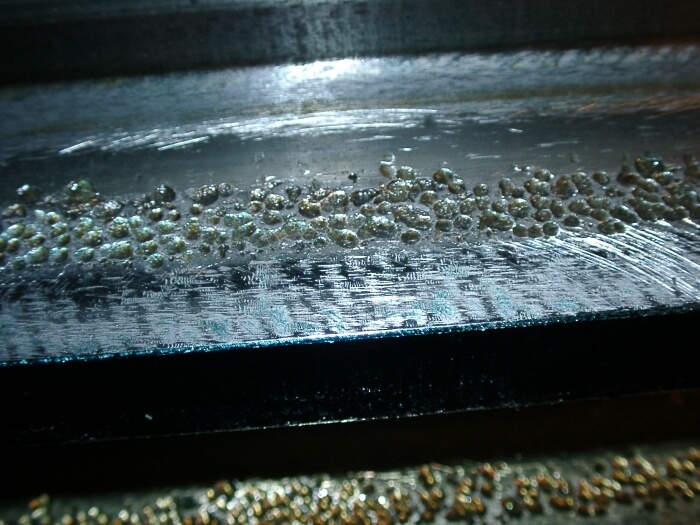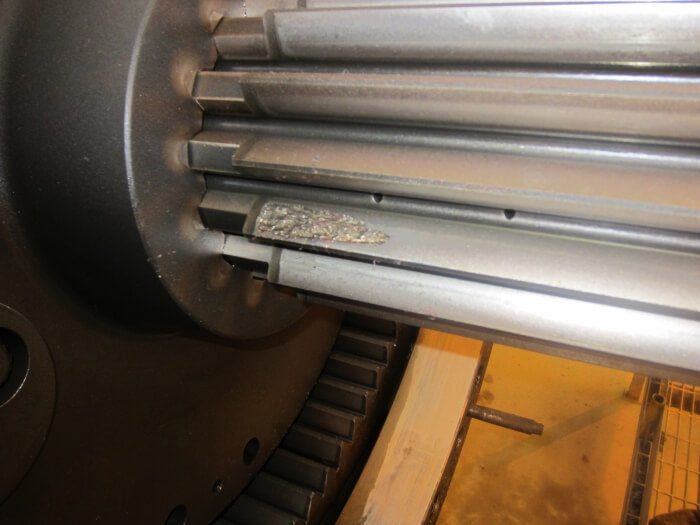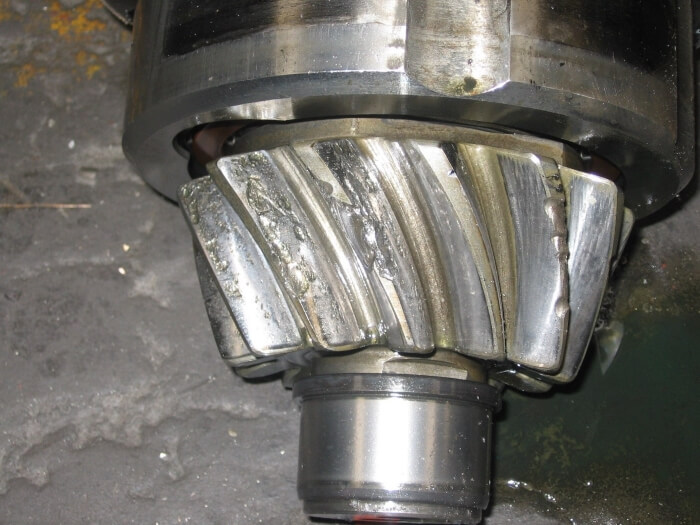


Pittings on gearboxes
Pittings are defined as damage that occurs when two friction partners press too hard against each other and the material successively breaks out due to high loads. This can occur on industrial gear units, for example, when the tooth flanks slowly wear (abrasive wear) due to high pressure. This is also known as macro-pittings.
Micropittings or grey spots are often the preliminary stage of pitting and represent a similar, softened damage pattern.

Development of pittings
Pittings occur when the material strength of friction partners is exceeded due to previous damage, such as seizure or fatigue (micro-pittings). Due to continuous loading of the materials, the smallest cracks form on the surface. The crack structure usually spreads out at an angle of 90° and causes the material to break out in the shape of a shell. From a physical point of view, this occurs when the strength of a material is exceeded due to Hertzian pressure. This occurs both on rolling bearings and on gears. In Hertzian pressing, the maximum component stress is not generated at the component surface, but below the surface. This favours the outbreaks.
The friction partners are often not perfectly matched to each other, which results in constant contact between the surfaces. In addition, it is likely that the lubricant used does not have sufficient load-bearing capacity, which means that the lubricating film between the friction partners cannot be maintained continuously. If the oil is not able to withstand the high load, the first thing that occurs is micro-pitting and later larger breakouts or pittings. Foreign bodies in the lubricant due to insufficient filtration can also affect the surfaces of the gears or rolling bearings.

Gear damage due to pittings
The formation of dimples can already occur during the running-in phase of a gearbox if the friction partners do not mesh perfectly with each other. In most cases, however, this form is still harmless. Only when the friction partners touch each other over a longer period of time does material fatigue occur, which destroys the tooth flanks. First, individual break-outs or dimples can be detected; later, severe damage to the gear teeth can occur. This means that the gear no longer ensures optimum power transmission and must be repaired or replaced. This inevitably leads to a longer downtime of the system.

Prevention of pitting
There are some preventive measures to exclude pittings in the operation as best as possible.
- Select a high flank hardness for the gears to increase the robustness of the material
- Select materials that can withstand the pressure and peak temperature that occur during operation
- Use larger radii of curvature for the friction partners
- Precise gearing installation
- Observe regular maintenance and servicing of the system according to the manufacturer's instructions
- Examination of the oil samples of the plant in order to detect any foreign material ingress due to wear at an early stage
- Maintain optimum filtration of the lubricant
- Sufficient lubrication of the friction partners with viscous oils to prevent direct contact between the friction partners
Especially with the last point we from ADDINOL can support you in the best possible way. With our products from the Eco Gear M/S range, we offer the best surface protection for your gearbox or rolling bearing. We combine a high lubricant film thickness with low power loss due to the lubricant. Our gear oils are very pressure-resistant and ensure perfect separation of the friction partners. This prevents surface corrosion and wear. The Surftec technology of our lubricants helps you even with pre-damaged gears by smoothing and hardening the breaking edges. This allows you to operate your gearbox for a long time and minimize downtimes. This saves a lot of money in the long run through fewer gearbox repairs and downtimes.

Gear oils against pittings
The right oils help against pittings on gearboxes. The ADDINOL Eco Gear ranges are specially designed to prevent pitting on gears. We recommend the series Gear Oil F, Eco Gear M and Eco Gear S. The gear oils are available in different viscosity classes and are therefore suitable for many OEM approvals. Let us advise you in case of ambiguities.
ADDINOL GEAR OIL 220 F
Specifications / Approvals:
DIN 51517-3 (CLP), ISO 12925-1, AGMA 9005-E02, Siemens MD (Flender Rev. 15)
ADDINOL ECO GEAR 220 M
Specifications / Approvals:
DIN 51517-3 (CLP), ISO 12925-1
erfüllt die Anforderungen an:
Flender
ADDINOL ECO GEAR 220 S
Specifications / Approvals:
DIN 51517-3 (CLP), ISO 12925-1, AGMA 9005-E02
erfüllt die Anforderungen an:
Flender

